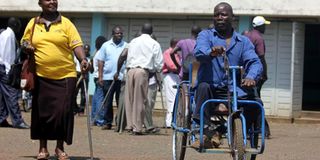Disability-friendly urban design ensures inclusivity

Semi-accessible footbridges and little or no public awareness on white cane renders people with mobility and visual disabilities unsafe.
Kenya ratified the Convention on the Rights of Persons with Disabilities (CRPD) in 2008, committing to address accessibility across interventions, policies and programmes and provide access to physical environment, inclusive transportation, information and communication, technology systems and other public facilities and services to PWDs on an equal basis with others.
The CRPD promotes universal design and inclusive environment. This is anchored on the principles of equitable use, flexibility, simple and intuitive use, perceptible information, tolerance for error, low physical effort and appropriate size and space for use. Integrating equity in development through increased access to public resources and opportunities to all are the ideals of New Urban Agenda.
The renewal and regeneration in cities have seen development of roads and walkways to ease vehicular traffic congestion and enhance the shared space for non-motorists. Relocation of markets and upgrading of recreation facilities and housing aim for better planned cities and improved service delivery.
Regrettably, the promising urban future is inequitable and unjust to persons with disabilities (PWDs). Physical access is far from reach with non-dual pedestrian walks which lack accessibility features like tactile marks to alert blind persons of potential hazards in the walkways.
Parking lots
Not reserving parking lots for PWDs after constructing pedestrian walkways on previously reserved space for accessible parking lots locks them out. Using the few accessible toilets as storage rooms for cleaners, non-gender disaggregation of washrooms and private ownership of the facilities deny PWDs dignified use of public spaces.
Inability of the visually and hearing impaired persons to independently navigate the city traffic system due to lack of appropriate technology like functional traffic light detection, cross watch system and audible pedestrian signals is exclusive.
Semi-accessible footbridges and little or no public awareness on white cane renders people with mobility and visual disabilities unsafe. The long distance between the passenger drop zones and public facilities like offices, markets and business premises, coupled with the ‘matatu culture’, of driving off before passengers fully board or alight, is extremely risky to PWDs.
“Smart cities” are anchored on technology as the driver of development but “just cities” on dignity, democracy, equity and diversity, rights and responsibility of urbanites. To achieve just cities, city planners and urban developers must put accessibility at the core of urban design and development, uphold principles of universal design, embrace spatial justice and engage PWDs in urban development.
Secondly, in this Covid-19 era, all actors must boost uptake of technological innovations in accessibility to reduce vulnerability of PWDs to the virus. Thirdly, county governments must ensure there is dignity, equity and diversity, rights and responsibilities and democracy in planning and implementation of urban development initiatives.
Ms Omino, a disability justice activist, is a member of the Just City Working Group. [email protected]. @MILDREDOMINO





